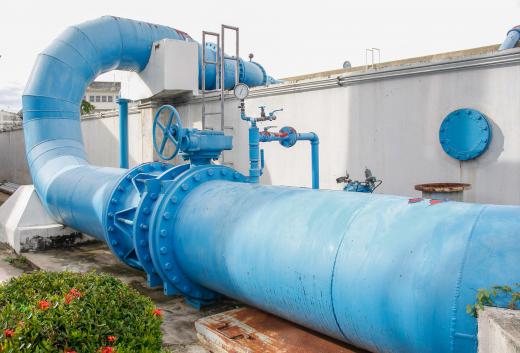A waste converter is a type of machine that takes industrial byproducts or residential and municipal garbage and sewage and processes it into material that is both environmentally safe and useful as either a fuel source or raw material for other types of manufacturing. Waste treatment has evolved as a better understanding of how organic and synthetic materials can be broken down into simpler and safer compounds. The process replaces earlier methods of waste disposal that have significant environmental impacts, such as the widespread use of landfills and incinerators. Depending on the nature of the waste itself, a waste converter is usually designed to pasteurize and sterilize waste in the process to make sure that the end products produced are safe for further human use.
One of the earliest forms of sterilization of waste that was contaminated with bacterial germs or other pathogens was that of the waste autoclave. The autoclave has been a staple piece of equipment in biological laboratories since it was invented in 1879, and hospitals and industrial settings that deal with organic materials have relied on it for years. Small versions of autoclaves are used to sterilize surgical tools, and large ones to sterilize medical and biological waste prior to disposal or incineration, but both work on the principle of killing microorganisms by subjecting them to high pressures and super-heated steam. As technology has advanced, a waste converter for sterilizing biological materials like an autoclave no longer requires high pressures or the addition of water, as the water in the material itself is converted to steam.

The thermal treatment of waste by incinerators has also posed health problems because it creates noxious gasses that are released into the environment such as dioxins. This makes living near an incinerator a health risk equivalent to that of the risks from other pollution such as from the paper mill and nuclear power industries. Plasma arc waste treatment is seen as a safer, less polluting alternative. The thermal process that a plasma arc system uses is known as pyrolysis or plasma gasification.
Using electrical current to create an ionized gas known as plasma, such a waste converter operates at a temperature of around 10,000° Fahrenheit (5,538° Celsius). The production of the plasma does not require the presence of oxygen, so little actual burning of the waste takes place. The decomposition of the materials in a plasma arc waste converter is done entirely by the application of heat, and the gasses that are produced are generally used as fuel to power the electrical generation of the plasma arc itself. Metals produced are saved as slag and sold to metal refiners or the construction industry, and remaining inorganic materials are vitrified into a type of sterilized glass.
Another form of waste converter used as of 2011 is the biological converter for sewage from municipalities and agriculture. These converters use fermentation processes to create ethanol and other types of organic fuels. Some of these waste converter systems are also built into landfill sites to generate and capture methane gas as a form of fuel.
A variation on biological waste converter systems was developed in Norway for the disposal of residential food waste as a better alternative to that of composting. It is faster than composting and reduces 90% of the original waste mass within 18 hours. In industries where large amounts of food waste are produced, such as by restaurants and hotels, the system is seen as an efficient way to convert food waste into a type of sterilized organic fertilizer. The machinery is also of particular interest to nations such as The United Arab Emirates, that produce large amounts of organic waste but have little available land for landfill use. The 2010 Middle East Waste Summit (MEWS) presented the system to regional Arab states looking at adopting it, as well as other nations in the region such as Israel.
